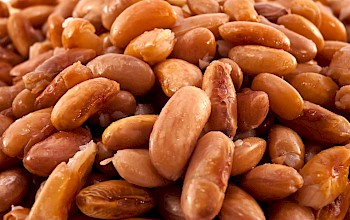Vegetable Soup: Calories and Nutrition Analyse
How many calories in vegetable soup?

Nutrition Facts
Vegetable SoupServing size:
standard serving size (1 cup) of vegetable soup (240 g) change
5g10g15g20g30g40g50g60g80g100g120g140g160g180g200g220g250g300g350g400g450g500g600g700g800g900g1000g
1oz2oz3oz4oz5oz6oz7oz8oz10oz12oz15oz20oz25oz30oz35oz40oz50oz
Amount Per Serving:
100g of vegetable soup contain about 38 calories (kcal).
Calories per:
ounce
| standard serving size, half cup
| bowl
For example, a standard serving size (1 cup) of vegetable soup (240 g) contain about 91 calories.
This is about 5% of the daily caloric intake for an average adult with medium weight and activity level (assuming a 2000 kcal daily intake).
Scroll down for details and nutrition tables.
To visualize how much 91 kcal actually is, keep in mind that the calorie content of vegetable soup is similar to that of, for example:
- 1.5 apples
- 1 glass of Coca Cola (220 ml glass)
- 0.5 slice of cheese
- 0.5 slice of bread
- 0.5 glass of milk
- 4.5 cubes of sugar
Take a quick look at the tables below for detailed information about vegetable soup nutrition.
100g of Vegetable Soup
Nutrition
- Calories38
- Carbs Total6.24 g
- Dietary fiber1.2 g
- Fat0.87 g
- Protein1.82 g
- Water90.02 g
Vitamins
- Vit A54 IU
- Vit B1 (Thiamine)0.042 mg
- Vit B2 (riboflavin)0.038 mg
- Vit B3 (Niacin)0.987 mg
- Vit B60.086 mg
- Vit B9 (Folic acid)0.013 mcg
- Vit C6.8 mg
- Vit E0.2 mg
- Vit K0.017 mg
Minerals
- Potassium181 mg
- Magnessium11 mg
- Calcium14 mg
- Sodium242 mg
- Iron0.48 mg
- Beta karoten536 mg
Unlocking the Nutritional Secrets of Vegetable Soup
Vegetable soup is more than just a comforting meal; it's a powerhouse of nutrition packed into every spoonful. With its rich array of vegetables, it's no wonder that this humble dish is celebrated for its health benefits. But what exactly makes vegetable soup so good for you? Let's dive into the nutritional content of vegetable soup and discover its role in a healthy diet.
Calories and Macronutrients
One of the most appealing aspects of vegetable soup is its low calorie content. A standard serving contains approximately 38 calories, making it an excellent choice for those monitoring their calorie intake. Despite its low calorie count, vegetable soup does not skimp on nutrients.
- Carbohydrates: With about 6.24 grams of carbs, including 1.2 grams of dietary fiber, vegetable soup can help you feel full and satisfied. The fiber content is particularly beneficial for digestive health and can aid in weight management.
- Protein: Vegetable soup provides a modest 1.82 grams of protein per serving. While not a high-protein food, it can contribute to your daily protein intake, especially when paired with a protein-rich side dish.
- Fat: The total fat content is low at 0.87 grams per serving, with negligible amounts of saturated fat. This makes vegetable soup a heart-healthy option.
Vitamins and Minerals
Vegetable soup is a treasure trove of vitamins and minerals, essential for maintaining good health. Here are some highlights:
- Vitamin A: With 54 IU per serving, vegetable soup contributes to healthy vision, immune function, and skin health.
- Vitamin C: Each serving contains 6.8 mg of vitamin C, known for its antioxidant properties and its role in collagen production.
- Iron: The 0.48 mg of iron per serving is vital for oxygen transport in the body.
- Potassium: With 181 mg, vegetable soup can help maintain a healthy blood pressure level.
Hydration and Sodium Content
Vegetable soup is also an excellent source of hydration, with water making up 90.02% of its composition. However, it's worth noting the sodium content, which stands at 242 mg per serving. While not excessively high, those watching their sodium intake should consider this factor, especially if consuming store-bought or canned varieties.
Conclusion
Vegetable soup is a nutritional powerhouse, offering a low-calorie meal option that is rich in vitamins, minerals, and fiber. Its low fat and protein content make it an ideal choice for those looking to maintain or lose weight, while its array of nutrients supports overall health. Whether you're enjoying a homemade batch or a store-bought version, vegetable soup is a delicious way to nourish your body and soul.
How many calories are there in 1, 2, 3, or 5 servings of vegetable soups?
- Standard serving size (1 cup) of vegetable soup (240 g)91 kcal
- Half cup of vegetable soup (120g)46 kcal
- Vegetable soup bowl (480g)182 kcal
- Ounce (oz) of vegetable soup11 kcal
- Half of medium size servings of vegetable soup45.5 kcal
- Small size serving of vegetable soup (192g)72.8 kcal
- Big size vegetable soup (312g)118.3 kcal
- Two medium size servings of vegetable soups182 kcal
- Three medium size servings of vegetable soups273 kcal
- Four medium size servings of vegetable soups364 kcal
- Five medium size servings of vegetable soups455 kcal
Compare vegetable soup:
vegetable soup vs Burger King hamburger, vegetable soup vs pizza, vegetable soup vs mushroom soup, see all compares of vegetable soup.

Similar calories number have:
See also:
Read this:
- How many calories does oyster have?
- Calories in a half of beignet
- Calories in whole beignet
- Calories for one, two or more beignets
- How many carbs (carbohydrates) in bran muffin?
- How much fat in reuben sandwich?
- How much protein in Laffy Taffy Candy?
- What is weight of potato patty?
- Pork rinds calories per ounce (oz)
- Strawberry Pop Tart calories per serving size



Add comment